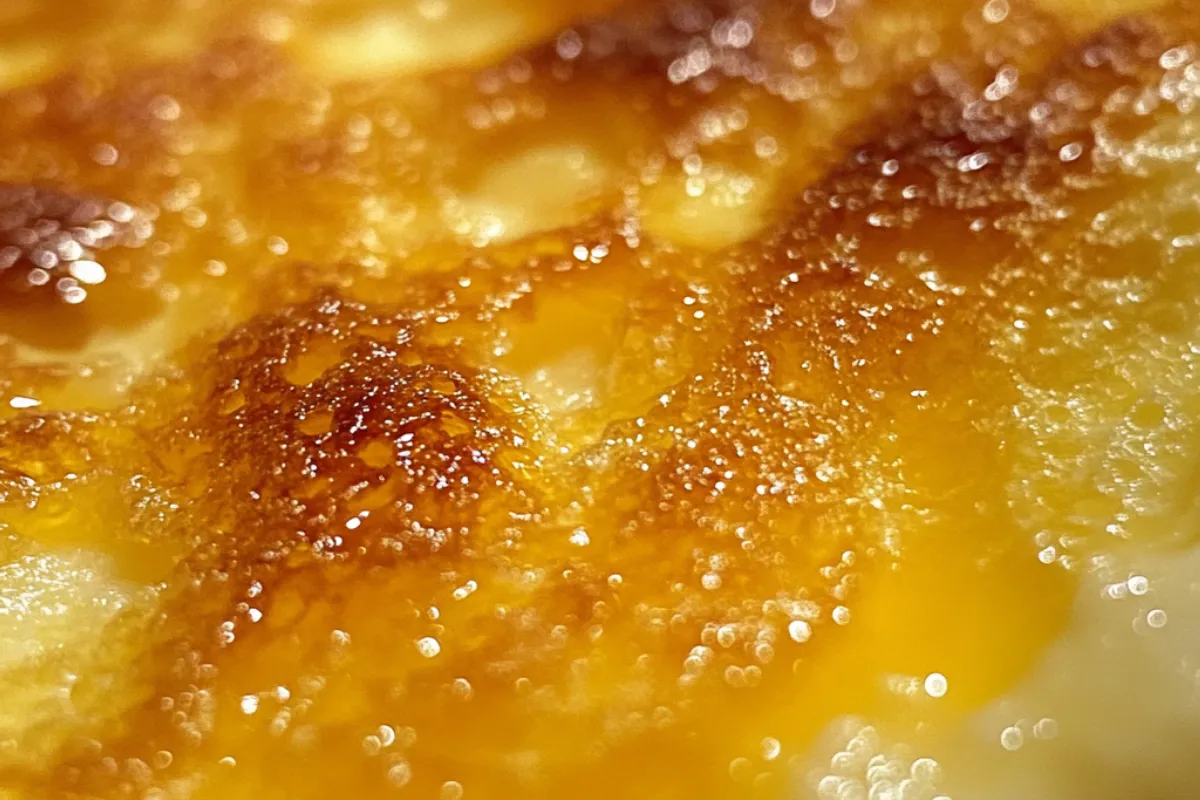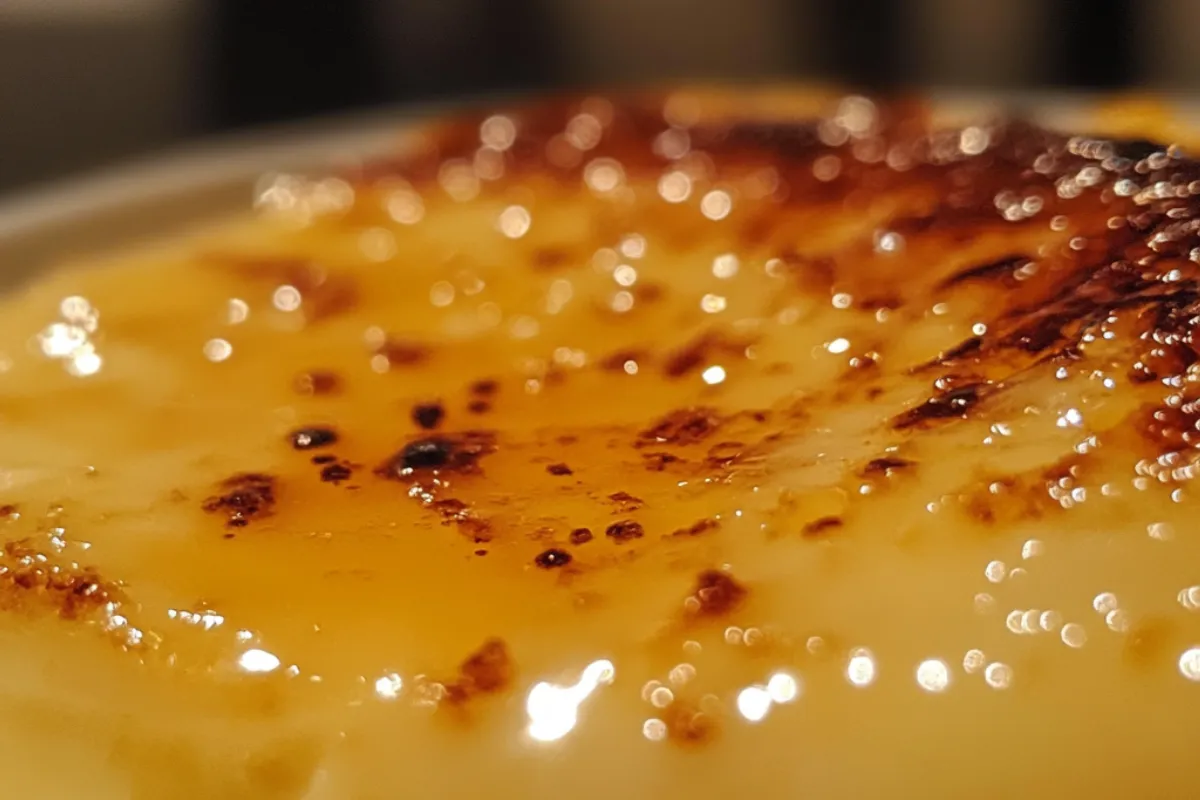Crème brûlée, the classic French dessert, is known for its smooth, creamy custard and crunchy caramelized sugar top. While preparing the custard is relatively straightforward, mastering the art of caramelizing the sugar to perfection can take your dessert to the next level. In this guide, we’ll explore everything you need to know about how to properly caramelize crème brûlée, including techniques, the best sugars to use, and common mistakes to avoid.

What is Caramelization?
Caramelization is the process where sugar melts and changes color and flavor when exposed to heat. This transformation results in a nutty, rich flavor with a golden-brown color, providing that iconic crispy topping on crème brûlée. The key to a successful caramelized crust is evenly distributing sugar and controlling the heat source for even browning without burning.
If you want to explore more about the science behind caramelization, this guide explains it well.
Best Sugars for Caramelizing Brûlée
The choice of sugar plays a significant role in determining the outcome of your caramelized crust. Here are the most common options:
- White Granulated Sugar: This is the most popular sugar for crème brûlée because it caramelizes evenly and quickly. Its fine crystals ensure smooth coverage across the custard.
- Superfine (Caster) Sugar: This sugar has smaller crystals, allowing for faster melting and a glass-like surface. If you’re looking for precision and consistency, superfine sugar is an excellent option.
- Turbinado or Demerara Sugar: These raw sugars have larger crystals and add a deeper molasses flavor to the caramelized layer. However, they take longer to melt and can create a thicker, crunchier crust.
To achieve the best results, it’s essential to understand how the size and type of sugar crystals affect the caramelization process. Superfine sugar, for example, melts faster and results in a smoother finish. On the other hand, Turbinado sugar may give your brûlée a more rustic texture and flavor, though it requires careful attention to prevent burning. If you’re interested in experimenting with different methods, you can try this oven caramelization guide.
How to Caramelize Crème Brûlée: Techniques
There are a few different methods to caramelize crème brûlée, depending on the tools you have available. The two most common techniques are using a culinary torch or broiler. Both have their advantages, and knowing how to use each method will ensure a perfectly caramelized crust every time.
Torching Method
A culinary torch is the preferred method for caramelizing crème brûlée because it provides more control over the heat and allows for even caramelization. Here’s how you can do it:
- Prepare the Sugar: After the custard has been chilled, sprinkle a thin, even layer of sugar (about 1–1.5 teaspoons) over the top.
- Light the Torch: Hold the torch at a 45-degree angle, about 2–3 inches above the sugar.
- Move in a Circular Motion: Keep the flame moving in small, circular motions to evenly melt the sugar. Be sure not to hold the flame in one spot for too long to avoid burning.
- Wait for the Right Color: Stop torching once the sugar has turned golden brown and slightly bubbly. Allow it to cool and harden into a crisp crust.
Broiling Method
If you don’t have a culinary torch, you can caramelize crème brûlée in the oven under the broiler. While this method can work, it requires more careful monitoring since the heat can be less evenly distributed.
- Preheat the Broiler: Set your oven’s broiler to high.
- Sprinkle the Sugar: Just like with the torch method, sprinkle an even layer of sugar over the custard.
- Place Under the Broiler: Position the crème brûlée about 5–6 inches below the broiler.
- Watch Closely: Keep an eye on the sugar as it melts, rotating the ramekins as necessary to ensure even caramelization.
- Cool and Set: Once the sugar turns golden brown, remove the ramekins and allow the sugar to harden.
Common Mistakes to Avoid
Even with the best intentions, a few mistakes can occur when caramelizing crème brûlée. Here’s what to watch out for:
- Over-Caramelizing: If you hold the flame too long in one spot or leave the brûlée under the broiler for too long, the sugar can burn and turn bitter. Always keep the heat moving to avoid this issue.
- Uneven Sugar Layer: Be sure to sprinkle the sugar evenly across the surface. If certain areas have more sugar than others, you’ll end up with an uneven crust.
- Using Too Much or Too Little Sugar: Too much sugar will result in a thick, overly crunchy layer that’s difficult to crack, while too little sugar may not provide enough caramelization.
Advanced Caramelization Techniques
For those looking to elevate their crème brûlée game, there are a few advanced caramelization techniques that you can try. These techniques are great for achieving a unique texture or flavor profile and can impress guests with your culinary skills.
Double Caramelization
A unique twist is to apply two layers of caramelization. After caramelizing the first layer, let it cool completely, then add a second thin layer of sugar and repeat the caramelization process. This results in an extra crispy, thick sugar crust that crackles beautifully when tapped with a spoon.
Flavored Sugars
Another technique to experiment with is using flavored sugars. You can infuse sugar with natural flavors like vanilla, cinnamon, or citrus zest. To do this, simply mix the sugar with your flavoring of choice and let it sit for a few hours to absorb the essence. Then, strain the sugar and use it as you normally would for caramelizing. The result is a subtle twist on the traditional brûlée flavor.

The Science of Sugar in Crème Brûlée
Understanding the science behind caramelization can help you perfect your brûlée. When sugar is heated, it undergoes a process called the Maillard reaction, where sugars break down and create new flavors and colors. The key is to reach just the right temperature so that the sugar melts without burning. Achieving this perfect balance will give you a smooth, glossy caramelized layer that adds both texture and flavor to the dessert.
Tools You’ll Need
To caramelize crème brûlée, you’ll need a few essential tools:
- Culinary Torch: This is the most important tool for caramelizing the sugar evenly and with precision. It allows for better control and quicker caramelization.
- Broiler: If you don’t have a torch, your oven’s broiler can be a good alternative. However, it’s less precise, and you’ll need to watch it carefully to avoid burning.
- Spoon or Sugar Sifter: To ensure even sugar distribution, a sugar sifter can be very helpful. Alternatively, use a spoon to spread the sugar in a uniform layer.
Best Recipes for Caramelizing Crème Brûlée
Now that you know how to caramelize crème brûlée, here are some recipe variations you can try:
- Classic Crème Brûlée: This is the traditional recipe that features a rich vanilla custard with a perfectly caramelized sugar top.
- Caramel Crème Brûlée: For a twist, you can try a caramel version by incorporating caramelized sugar into the custard base itself. This creates a deeper, richer flavor.
- Healthier Crème Brûlée: You can experiment with alternative sugars like coconut sugar for a healthier option that still provides the sweet, crunchy topping.
To discover more exciting recipe variations, this resource offers some delicious options.
Pairing Crème Brûlée with Other Desserts
Crème brûlée is a versatile dessert that pairs wonderfully with other treats. Consider serving it alongside a berry compote, which adds a refreshing tartness that balances the rich custard. Another option is to present it with delicate cookies like biscotti or shortbread, which add a satisfying crunch.
For more ideas on pairing flavors, take a look at our guide on Churro Cheesecake, where combining textures and flavors creates a delightful dessert experience.
The Perfect Occasion for Crème Brûlée
Crème brûlée is often associated with fine dining and elegant occasions, but it’s also a great dessert for casual gatherings or even family dinners. Its simplicity in ingredients makes it accessible for home cooks, while its striking presentation never fails to impress.
If you’re planning a dinner party and looking for a dessert that pairs well with different courses, crème brûlée can be your go-to. It works especially well after heavier meals because the creamy, light custard offers a smooth, sweet finish without being too filling.
For other dessert inspiration to pair with crème brûlée, explore our Strawberry Shortcake Ice Cream Recipe for a refreshing complement.

FAQs About Caramelizing Brûlée
Can you caramelize crème brûlée without a torch?
Yes, you can use the broiler method if you don’t have a culinary torch. Just be sure to monitor the sugar closely to avoid burning.
How long do you torch crème brûlée?
The process usually takes about 1–2 minutes. You’ll want to move the flame around continuously and stop once the sugar is golden brown.
What temperature should you use to broil crème brûlée?
Set your broiler to high and position the ramekins about 5–6 inches below the heat source.
Why is my crème brûlée sugar not caramelizing?
If the sugar isn’t caramelizing, it’s possible that your torch or broiler isn’t hot enough. Make sure the heat source is at its highest setting for best results.
Final Tips for Perfect Caramelization
As you practice caramelizing crème brûlée, remember that achieving a perfect caramelized crust is about precision, timing, and the right sugar choice. Whether you’re using a torch or a broiler, the key is to apply even heat and keep an eye on the sugar’s color as it melts. A light, golden-brown hue is what you’re aiming for. With practice, you’ll soon be able to create restaurant-quality crème brûlée right in your kitchen.
By following these steps and avoiding common mistakes, you’ll master the art of caramelizing crème brûlée. Happy cooking!

